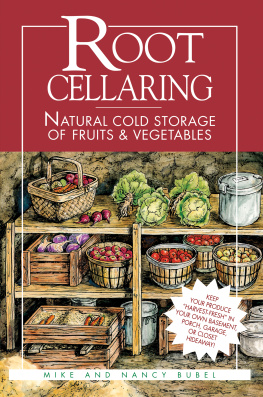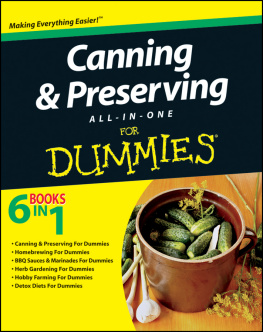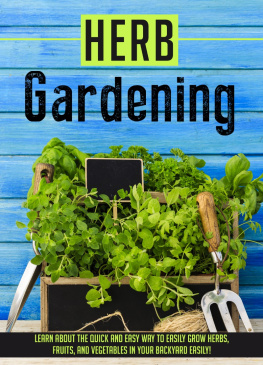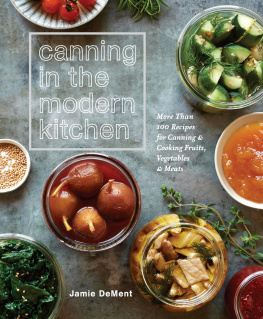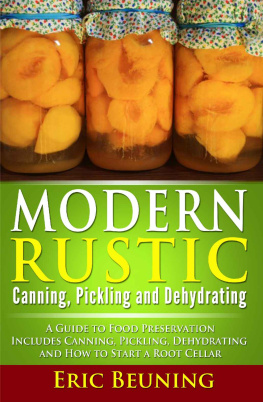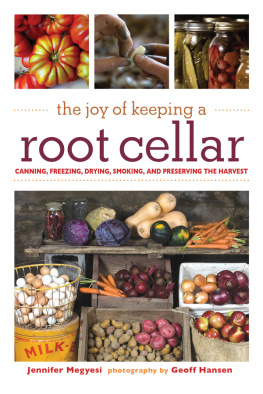ROOT CELLARING
Other Bubel Books:
- Vegetables Money Cant Buy
- Working Wood
- The Seed-Starters Handbook and The New Seed-Starters Handbook
- The Country Journal Book of Vegetable Gardening
- 52 Weekend Garden Projects
The mission of Storey Publishing is to serve our customers by publishing practical information that encourages personal independence in harmony with the environment.
Cover design by Carol Jessop
Book design by Jerry OBrien
Illustrations by Keith Heberling
Photos by Mike Bubel
Text Production by Cindy McFarland
1991, 1979 Mike and Nancy Bubel
Ebook production by Kristy L. MacWilliams
Ebook version 2.1
August 16, 2017
All rights reserved. No part of this book may be reproduced without written permission from the publisher, except by a reviewer who may quote brief passages or reproduce illustrations in a review with appropriate credits; nor may any part of this book be reproduced, stored in a retrieval system, or transmitted in any form or by any means electronic, mechanical, photocopying, recording or other without written permission from the publisher.
The information in this book is true and complete to the best of our knowledge. All recommendations are made without guarantee on the part of the author or Storey Publishing. The author and publisher disclaim any liability in connection with the use of this information. For additional information, please contact Storey Publishing, 210 MASS MoCA Way, North Adams, 01247.
Storey books are available for special premium and promotional uses and for customized editions. For further information, please call 1-800-793-9396.
Library of Congress Cataloging-in-Publication Data
Bubel, Mike.
Root cellaring: natural cold storage of fruits & vegetables / by Mike Bubel & Nancy Bubel.2nd ed.
p. cm.
Includes bibliographical references and index.
ISBN 978-0-88266-703-4 (pbk.)
1. Vegetables Storage. 2. Fruit Storage. 3. Vegetable gardening. 4. Root cellars. 5. Food Storage. I. Bubel, Nancy.
II. Title.
TX612.V4B79 1991
641.452 dc20
91-55012
CIP
Acknowledgments
Grateful acknowledgment is made to the following publishers for permission to reprint copyrighted material from the following sources:
Countryside Magazine: Energy-Free Food Storage by Jerry Minnich. Copyright October 1977. Reprinted by permission.
Bookcraft Inc.: Passport to Survival by Esther Dickey. Copyright 1969 by Esther Dickey. Reprinted by permission.
Harcourt Brace Jovanovich, Inc.: Food for Thought by Robert Farrar Capon. Copyright 1978. Reprinted by permission.
Houghton Mifflin Co.: Basic Baskets by Mara Cary. Copyright 1975 by Mara Cary. Reprinted by permission.
Funk and Wagnalls: Diary of an Early American Boy by Eric Sloane. Copyright 1962 by Eric Sloane. Reprinted by permission.
Doubleday and Company Inc.: My Friend the Garden by Fernand Lequenne. Copyright 1965 by Fernand Lequenne. Reprinted by permission.
Doubleday and Company Inc.: The Countrymans Year by David Grayson. Copyright 1932 by David Grayson. Reprinted by permission.
Shambala Publications, Inc., 1123 Spruce Street, Boulder, Colorado 80301: Tassajara Cooking by Edward Espe Brown. Copyright 1973 by Edward Espe Brown. Reprinted by special arrangement.
Crabapple Press, Meadville, Pennsylvania: The Farm Cellar by Eupha Shanly, page 86. Poor Joes Pennsylvania Almanac 1979. Reprinted by permission.
Grateful acknowledgment is made to William H. Matchett for permission to reprint a portion of his poem Packing a Photograph from Firenze, from Water Ouzel and Other Poems, published by Houghton Mifflin. Copyright 1955 by William H. Matchett. Reprinted by permission.
Wed like to dedicate this book
to the memory of Mikes mother,
Mary Bubel.
This time, like all times, is a very good one if we but know what to do with it.
Ralph Waldo Emerson
Contents
Preface
Slowly we are carving a new lifestyle. To some it might seem to be one that is looking backward, for it cherishes the homely, the rude, the unpackaged, the unmechanized, the careful. We do not think of it as a blind shutting out of any visions of the future, but rather, for us, the right way to face the future. The carving is not easy. It is often painful. But in it are the seeds of sanity, of joy.
Mara Cary Basic Baskets
Our interest in root cellars goes way back to the years when our children were young and we were driving the back roads of central Pennsylvanias lovely Buffalo Valley in search of a farm to buy. On one of our rambles, we discovered a real beauty a classic stone-faced root cellar dug into a hill. We wished, as only a land-hungry young couple can, that it belonged to us. In a way, that splendid old root cellar does belong to us, because Mike took a picture of it a picture that we still enjoy looking at now that weve found some land of our own and settled in. In another sense, the cellar belongs to us because living with that picture has influenced us. It has said something to us about forethought, preparation, and generous provisioning and about building a pleasing structure for even the most utilitarian purpose.
We have, in fact, come to see the root cellar as a true expression of folk craft a thing people make to serve their everyday needs. It is one of the few (mostly) unregulated things you can build in most communities today. The appropriate use of found materials to suit a particular site and family delights us with its varied, sturdy, homey results.

This is the old root cellar in Buffalo Valley, Pennsylvania, that got us started collecting root cellars.
Although weve done the usual sightseeing with our family Williamsburg, the Smithsonian, the Liberty Bell, Yellowstone Park, Broadway, and the beach we must confess that what really has most often intrigued us in our travels has been the little backyard gardens, homemade birdhouses, and north-slope root cellars weve seen along the way. When we finally realized that these are the things that have meaning for us, we started to take short rambling trips to search them out.
Our previous rather casual game of collecting root cellar ideas intensified when we started to plan a brand-new root cellar for the small house we intended to build here on our farm. In our search for the best root cellar plans, we consulted books and fellow gardeners and met many warm and interesting people along the way. We found so much good information that we decided it should be shared.
Thus this book has grown out of our interest in what people are really doing, on their own, to keep vegetables and fruits from the fall harvest for winter eating. We will tell you what a conventional root cellar looks like and show you how to build one, but we will also show you all kinds of improvised and ingenious systems that people have figured out for themselves, and that work.
There is something about a root cellar, for those who have experienced childhood winters of dependence on such stored bounty, that calls up associations of home and security. More than a few of our older informants grew misty eyed as they told us about root cellars they had hand-dug or once owned (including a built-for-the-ages masterpiece roofed by a century-old brick arch), or to which they had been sent as children to bring up the potatoes for dinner. One young contractor even told us how he left a big boulder exposed in the wall of a basement room of a house he had built because he remembered his grandfathers stone-walled root cellar and hoped that perhaps someone would appreciate that room.

